This page contains selected August 2002 submissions from photographers who wished to have their photographs reviewed
by the publisher of this site,Michael Reichmann, as well as by other readers on ourDiscussion Forum.
Edward M. Galle, Jr.
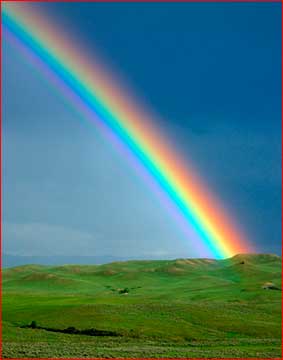
Edward M. Galle, Jr.
Houston, TX USA
edg@oilpatchtech.com
Canon EOS D60, Canon 28-135 IS w/polarizing filter
Took this right after a thunderstorm at Little Bighorn National Battlefield in Montana. Only slight level adjustment in PS. Have many other shots of this rainbow…it was a full (180-degree) double rainbow. The best one I’ve ever seen!
Michael’s Critique
The intensity of this rainbow is remarkable. A polarizing filter has been used to good advantage. Now if only there had been a strong foreground interest subject.
You can add your own comments on Edward’s photograph on the Critique section of ourDiscussion Forum.
Rahul Panse
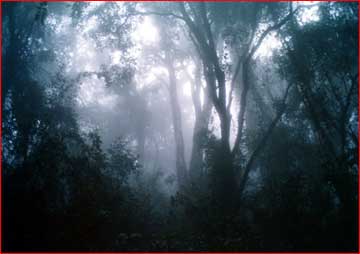
Rahul Panse
Bangalore, India
rahulp@digitalthink.com
Canon EOS Rebel 2000, Canon 28mm – 80mm, Kodak max 400
This picture is of a forest section of a place called Ooty in India. Ooty is a hill station in southern India. This photograph was taken in the month of February. It does not rain in Ooty during this time of the year, but when this picture was taken it was unusually foggy and cloudy which gave a nice effect to the picture.
Michael’s Critique
Photography is about exclusion as much as inclusion. The delicacy of the misty forest is detracted from by the large amount of black space at the bottom of the frame. It would be much stronger if this was cropped just below the lowest illuminated section.
You can add your own comments on Rahul’s photograph on the Critique section of ourDiscussion Forum.
Steve Marwedel
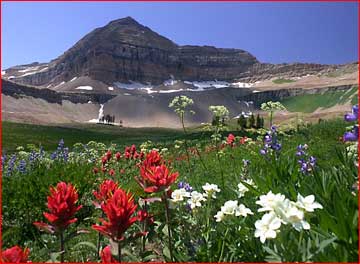
Steve Marwedel
Salt Lake City, USA
smar@sisna.com
Nikon Coolpix 995
WC-E63 Wide Angle Converter
Tamaron Circular Polarizer
A beautiful meadow in full bloom below the summit of Mount Timpanogas, Wasatch Mountain Range, Utah.
Michael’s Critique
This is a woderful exmaple of how the vast depth of field of digicams can be used to advantage.
You can add your own comments on Steve’s photograph on the Critique section of ourDiscussion Forum.
Eric Fredine
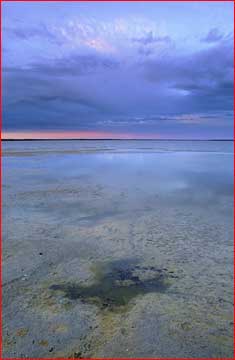
Eric Fredine
Edmonton, Canada
fredine@telusplanet.net
Taken with a Canon D30, 16-35, polarizer. I’ve lightened the foreground in Photoshop.
I was attracted to the texture of this lake bottom and the way it seemed to be echoed in the sky.
Michael’s Critique
Mystery and light work together well here. But placing the horizon near the center of the frame makes the upper and lower halves appear to be separate from each other. Camera placement looking up or down a bit would have changed this and made the composition more dynamic.
You can add your own comments on Eric’s photograph on the Critique section of ourDiscussion Forum.
Leigh Perry
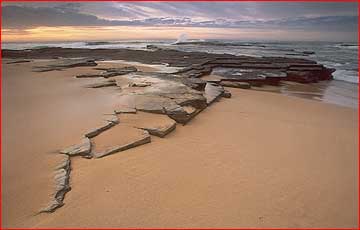
Leigh Perry
Sydney, Australia
lperry@breakpoint.com.au
Provia 100F, Canon 17-35L lens at 28mm, Canon EOS 50. Lee 3-stop graduated neutral density filter.
Digital processing: Curves, unsharp masking.
After a spectacular sunrise at Sydney’s Turimetta Beach, the sun went behind clouds and radiated diffuse warm light for an hour, providing that rarest of Australian photographic phenomena — an extended period of shootable light. A large version ishere.
Michael’s Critique
Here we see strong composition, arresting subject matter and sterling technique come together to create a very satisfying landscape photograph. Truely excellent in every respect.
You can add your own comments on Leigh’s photograph on the Critique section of ourDiscussion Forum.
Jeff Alu
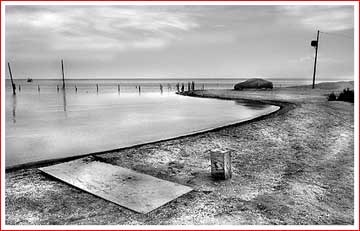
Jeff Alu
Irvine Ca, USA
animalu@animalu.com
Website: http://www.animalu.com/pics/photos.htm
This shot was taken at Bombay Beach, on the Salton Sea, in the summer of 2001. It was a very hot day, about 104 degrees when I took the shot. A commercial was being filmed for (I assume) the car in the photo. There were about eight director’s chairs behind me, and a bunch of scaffolding and equipment. But, no one was on the set, so I had it all to myself. I’m not ever sure what kind of car it was, and I never got much closer than this. I decided to include the boxes in the foreground, which were also being used for the shoot. The boat in the background had some locals doing some fishing. It was almost like the locals had driven up to the edge of the shore, covered their car, and taken their boat out for the day.
This was shot with a Kodak DC280 Digital camera, and processed/dodged and burned in Photoshop.
Michael’s Critique
Strong composition, accentuated by the S curve leads the eye to the car. Then we look back at the foreground object, wondering what they are. Mysterious and captivating. Very well seen and made more effective by having been rendered in B&W.
You can add your own comments on Jeff’s photograph on the Critique section of ourDiscussion Forum.
Lawrence Title
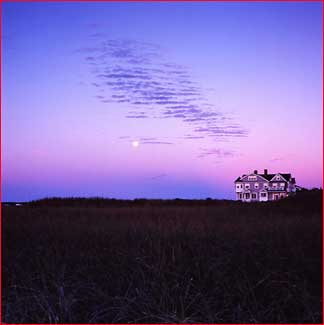
Lawrence Title
Halifax, NS, Canada
ltitle@hotmail.com
Hasselblad 202FA
lens 80/2.8
Lee 2 stop grad ND soft
film Provia 100F
don’t recall exposure data
This image was shot shortly after sunrise, after a full moon. Sstraight scan from transparency using Epson 2450, with minor curve alteration on PS to reproduce original slide color etc. Otherwise, no alteration with PS.
I was vacationing in Maine last month and spent about 4 days in Goose Rocks Beach (near Kennebunkport, ME). Although, initially I didn’t think the beach was going to offer much photographic potential, I was attracted to this beach house. I took many pictures of this house at various times in the morning and night during my stay. This was one of my favorites that I shot early in the am, after sunrise. I was especially drawn by the cloud formation, the moon, and sky colors. Normally, I shoot mainly B/W, but I went through a lot of Provia 100F on this trip.
Michael’s Critique
This photograph has a lot to commend it, but I’m distracted by the rigid adhenence to the square format. The bottom foreground adds nothing to the composition or visual interest and should have been cropped out.
The old cliche says, "If all you have is a hammer than everything looks like a nail". While I like finding square compositions when I’m shooting 6X6cm format, if the subject matter demands a rectangle, I don’t fight it.
You can add your own comments on Lawrence’s photograph on the Critique section of ourDiscussion Forum.
Bruce Buck
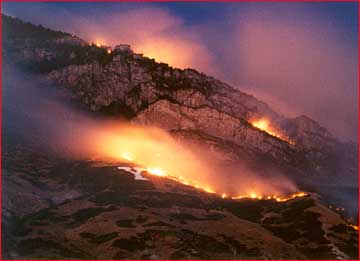
Bruce Buck
Provo, UT USA
azonicbruce@byu.edu
Minolta Maxxum 7000i
28-85mm Maxxum lens
400ASA film (generic)
30 second exposure
Scanned print
Walking home one day, and suddenly noticed the side of "Y mountain" in Provo, UT on fire. I quickly ran home and took pictures. Shutter speeds were too slow for good handheld shots so I grabbed my tripod and drove my car to a spot that was much closer. This shot was right as the sun was dipping below the horizon, and was also the very last frame on my roll of film. Whew! Link tolarger version.
Michael’s Critique
Fire can be much like water; a very long shutter speed causes it to appear fog-like. I like the way the fire has illuminated the clouds and appears to be flowing uphill. It’s sad, of course, that something so beautiful can be so damaging.
You can add your own comments on Bruce’s photograph on the Critique section of ourDiscussion Forum.
Matthew J. Cordery
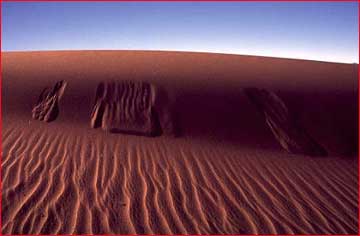
Matthew J. Cordery
Santa Rosa, CA
cordery@sonic.net
Location: Death Valley, CA
Film: Fuji Velvia
Camera: Olympus OM4
Lens: Olympus Zuiko 50mm
Michael’s Critique
There’s a wonderful ambiguity of colour to this dunes shot, and combined with the curious collapsed sections of sand makes for a fascinating image. It’s hard to do something different with dunes, yet Matthew has managed to show us this familiar location with a fresh eye.
You can add your own comments on Mathew’s photograph on the Critique section of ourDiscussion Forum.
Jeff Grant
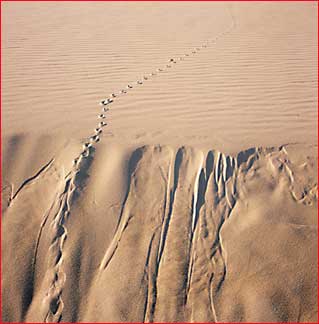
Jeff Grant
Sydney, Australia
Jeff.grant@pobox.com
Taken with a Hasselblad 503CW and 60mm Distagon on Provia 100F at Sandy Cape on Fraser Island.
I spotted these tracks in the sand and was taken by the way they just kept on going over the dune. This shot was taken late morning, but I was lucky enough to get a cloud obscuring the sun for a few minutes.A larger image.
Michael’s Critique
Sand again, but this time a more intimate view. The animal tracks are of course what make this shot, adding curiousity as well as leading the eye into the distance. This time the square format works well. and though the edge of the dune bisects the frame the fact that the trail is off center creates a dynamic composition.
You can add your own comments on Jeff’s photograph on the Critique section of ourDiscussion Forum.
Steven Jones
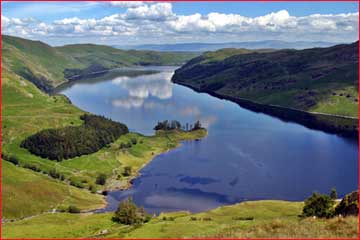
Steven Jones,
Southport, UK.
screemer@blueyonder.co.uk
Canon D60, 28-135 mm IS USM lens.
A picture of Haweswater reservoir in the Lake District, UK. Taken on a 6 mile walk around the area.
Michael’s Critique
My first response was, just-another-pretty-picture. Then I looked at the reflection of the clouds in the lake and how the dark shadow repeated on both sides of the lake and I liked it better.
The photograph might be more of-a-piece if the lake hadn’t been cropped on the right. It feels like it’s going to spill over the edge of the frame.
You can add your own comments on Steven’s’ photograph on the Critique section of ourDiscussion Forum.
Aaron Burghardt
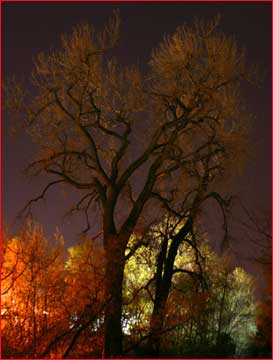
Aaron Burghardt
Denver, CO
aburgh@mac.com
Canon D60, 28-135 IS lens, 30 sec. exposure
This tree near my house is illuminated by a gas station behind/below it. I found this shot while walking a bike path after dark. What I saw with the naked eye was more of a silhouette, so I was surprised when I got back after taking the shot and saw this image with the tree almost jumping out of the screen. For me, it was a lesson in how much differently a camera can see a scene than the eye, and it has piqued my interest in night photography with long exposures.
Michael’s Critique
TheCanon D60is developing quite a reputations for the excellence of its low light capabilities. The D30 needed to invoke a long-exposure mode which had a processing time that doubled the exposure time, and even then with exposures longer than about 15 seconds things were noisy. Users of the D60 are reporting being able to do five and ten minute exposures that are relatively noise free.
Aaron’s photograph is fun because, as he points out, once light levels drop to a certain point the human eye no longer sees colour, while film and imaging chips still do. This makes can make the results surprising and fun to explore.
You can add your own comments on Aaron’s photograph on the Critique section of ourDiscussion Forum.
Paulo Bizarro
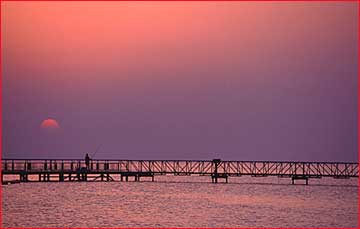
Paulo Bizarro
Carcavelos/Portugal
arbizarro@mail.telepac.pt
Eos 1V, EF 70-200 2.8, E100VS; Scanned with a Coolscan IV, adjustments in Photoshop;
This is Zallaq beach in Bahrain, at sunset. The strong colours are the result of the shamal wind blowing from Saudi Arabia, and bringing lots of dust into the atmosphere.
Michael’s Critique
Sunset, fishing pier, fisherman. A very familiar subject, but nicely executed. I receive many submissions that are just pretty sunsets, but even though the subject here is a something of a cliche, it’s when there’s an interesting foreground that they catch my attention.
You can add your own comments on Paulo’s photograph on the Critique section of ourDiscussion Forum.
Attila Kirjak
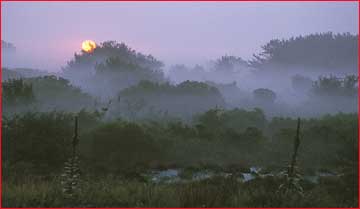
Attila Kirjak
New York City
http://www.kibo-studio.com
Canon 28-135IS @135mm f8.0 1/50 Av Eval +0.7 Provia 100F @320 Pushed +2, slight crop from top and bottom.
I was going to shoot some birds on Jones Beach and this spectacular sunrise presented itself for just a few seconds. Talk about not being prepared and not having the right lens with you…
Michael’s Critique
The makings are here, but they don’t quite gel. The soft morning light and fog, together with a diffused sun and vegetation should have worked, but there no focal point — nothing to bring them all together.
You can add your own comments on Attila’s photograph on the Critique section of ourDiscussion Forum.
Dave Yuhas
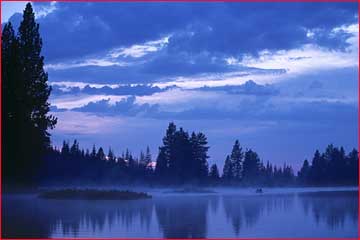
Dave Yuhas
Pacifica, CA
dyuhas@yahoo.com
http://www.photo.net/users/Dave_Yuhas/
Minolta 7000i, Sigma 70-200 f/2.8 APO lens, Velvia (@40), tripod, taken at f/8
I spent a week camping at Lake Manzanita while exploring Lassen Volcanic National Park. Each evening I took up a position across the lake from the spot where I took this shot. I was trying to get a nice sky behind Mt. Lassen. On my last evening in the park I decided to try to get a shot of the setting sun behind the trees with the lake in the foreground. The sunset fizzled, but I was intrigued by the scene.
Michael’s Critique
Fizzled sunsets are a photographer’s constant companion. We see the golden minutes coming, hope and wait and then.. nada. But in this case Dave has produced a lovely study in colour and form, showing that there’s more to landscape photography than pretty colours.
You can add your own comments on Dave’s photograph on the Critique section of ourDiscussion Forum.
All Photographs on This Page are the Copyright of Their Respective Photographers
All Rights are Reserved
You May Also Enjoy...
Photography Beyond The Landscape
FacebookTweet My Quest As A Photographer To Maximize The Power Of Photographic Art Through Photorealistic Compositing by James Porto I fell in love with photography at
Some Thoughts On The Leica X2
By Sean Reid of Reid Reviews On May 10, 2012, at a special event in Berlin, Leica introduced a 16 MP successor to their X1 camera

